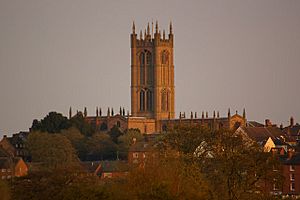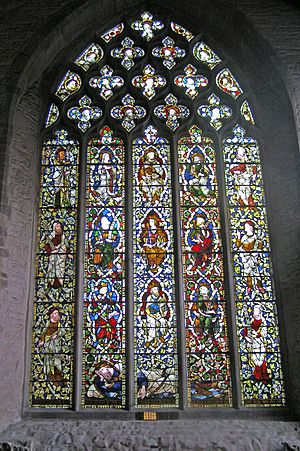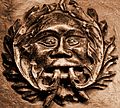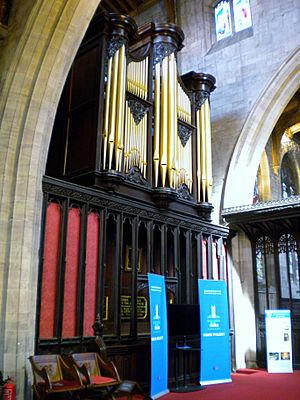St Laurence's Church, Ludlow facts for kids
Quick facts for kids St Laurence's Church, Ludlow |
|
|---|---|
 |
|
| Country | England |
| Denomination | Church of England |
| Churchmanship | Liberal Catholic |
| Website | stlaurences.org.uk |
| History | |
| Dedication | St. Laurence |
| Specifications | |
| Tower height | 157 feet (48 m) |
| Administration | |
| Parish | Ludlow St Laurence |
| Deanery | Ludlow |
| Archdeaconry | Ludlow |
| Diocese | Hereford |
| Province | Canterbury |
St Laurence's Church, Ludlow, is a beautiful Church of England parish church located in Ludlow, Shropshire, England. It is a very important historical building, recognized as a grade I listed building.
This church is part of the Greater Churches Group, which means it's one of the most important parish churches in England. It's also the biggest parish church in Shropshire. In a book called England's Thousand Greatest Churches, it was given a top five-star rating. Many people call it the "cathedral of the Marches" because it's so grand. About 70,000 people visit St Laurence's Church every year, making it a popular free attraction in the West Midlands.
Contents
History of St Laurence's Church
The church was first built when the town of Ludlow was founded by the Normans in the late 1000s. It sits on top of a hill, which is where the medieval town grew up around it. The church was rebuilt in 1199 and has been changed and added to many times since then.
The church's tower is 157 feet (48 meters) tall to the very top. From the tower, you can see amazing views of Ludlow town and the countryside around it. Inside, the church has special wooden carvings called misericords in the choir stalls. It also has beautiful stained glass windows.
Building the Church Through the Ages
When people explored under the south porch, they found parts of the original Norman church from the 11th century. After it was first built, the church was made bigger and rebuilt in 1199. This was to make space for more people as the town grew.
In the Middle Ages, Ludlow became very rich because of the wool trade. This wealth helped the church to grow even more. Major building work happened between 1433 and 1471. During this time, much of the nave (the main part of the church), the tower, and the chancel (the area around the altar) were rebuilt. The tower was built in a style called Perpendicular, which was popular in England in the late 1400s.
The Saint John's Chapel on the north side was used by a group called the Palmers' Guild. This group was very active in the Late Middle Ages. The Palmers' Window in St John's Chapel shows the story of King Edward the Confessor and St John the Evangelist. It has eight panels and was inspired by a pilgrimage the Ludlow Palmers made to the Holy Land in the 1200s.
In 1540, a historian named John Leland said the church was "very Fayre and large and richly adorned and taken for the Fayrest in all these parts." This means he thought it was very beautiful and grand.
Keeping the Church in Good Shape
The large east window in the chancel, which shows the martyrdom (death) of St Laurence, was repaired in 1832. The biggest repairs and changes happened between 1859 and 1861. This included new roofs, fixing stone and glass, and replacing all the floors and seats. More big repairs were done on the tower from 1889 to 1891, and on the roof from 1953 to 1959.
In 2008, a plan called Vision for St Laurence's started. This plan aimed to fix parts of the church that needed repair and make the building more useful for the community. About £850,000 was spent on urgent repairs, high-up stone work, roofs, and new heating and lighting. The church also made plans to change the nave with movable seating so it could be used for more community events. This work included a new nave floor, a kitchen, toilets, a shop, and repairs to old stained glass and wood.
Church Design and Features

The most noticeable part of the church from the outside is its square bell tower. This tower holds the church's famous old bells. Inside, the chancel has medieval choir stalls decorated with many misericords. These are amazing wood carvings found on the underside of hinged seats. Many of these carvings show heraldry (family symbols) or everyday scenes. The carvings are about 25 centimeters wide and 12 centimeters high, with very deep details. Some of the designs on the misericords are also seen on the roof decorations.
The chancel also has several monuments. Most of these mark the graves of people connected to Ludlow Castle's Council of Wales and the Marches. Besides the large east window, other windows in the chancel are special. One shows the Ten Commandments, with six panels illustrating commandments being broken.
The hexagonal (six-sided) south porch was built in the 1300s and is the main entrance to the church. This porch is one of only three such six-sided designs in all of England. Other chapels inside include St Catherine's Chapel and the Lady Chapel. The Lady Chapel has a large doorway that was once used for the Ludlow fire engine. Outside, you can find a stone memorial for the poet A. E. Housman on the north church wall near the West Door. There is also the Samuel Burgess Memorial Garden. Above the stone lantern inside, there is a beautiful vaulted ceiling.
Important People Buried Here
Many important people are buried at St Laurence's Church.
When Arthur, Prince of Wales, died at Ludlow Castle in April 1502, part of his body was buried in a lead box in the choir. Arthur was the son of Henry VII and the older brother of Henry VIII. His main burial place is at Worcester Cathedral.
Ambrosia Sidney (1565–1574), who was the sister of Sir Philip Sidney and Mary Sidney, died at Ludlow Castle when she was nine. She is buried near the altar under a grand memorial. Her father, Sir Henry Sidney, who was in charge of the Council of Wales and the Marches, also had his heart buried in a small lead urn near his daughter's tomb.
Sir John Bridgeman (1568/69 – 1638), a Chief Justice of The Marches in the 1600s, is buried in St Laurence's Church. His tomb monument is believed to be by the artist Francesco Fanelli.
Admiral James Vashon is also buried at St Laurence's.
The ashes of the poet A. E. Housman are buried in the church grounds. His poem "The Recruit" often mentions the church tower. A cherry tree stump marks where his ashes are, and a new cherry tree was planted nearby in 2003. The ashes of sculptor Adrian Jones are also buried in the church grounds. His memorial tablet is on the outside north wall, close to Housman's.
Inside the Church
Choir Stalls and Misericords
St Laurence's Church has twenty-eight misericords in the chancel. These are so well made that they are often compared to those found in great cathedrals like Worcester or Gloucester. Each misericord is carved from a piece of wood about 26 inches (660 mm) long, 12 inches (300 mm) deep, and 6 inches (150 mm) thick. Sixteen of these misericords are older, from around 1425. The rest were carved in a similar style around 1447.
-
Detail of a Green Man
The misericords show many different things. One shows a Green Man, and another a mermaid. Many show scenes from town life, like a wrestling match with two pairs of wrestlers. Another shows someone getting ale from a barrel, and one shows a dishonest ale-wife being taken to a bad place by demons playing bagpipes. A complex carving shows a rich householder with tools, a woman holding a child, and a grave. This carving might represent the Palmers Guild helping people from birth to death.
Since Ludlow was a royal stronghold, some misericords show royal symbols. An antelope was the symbol of Henry VI. A Hart at Rest was the symbol of Richard II, and three ostrich feathers were the symbol of Richard's father, the Black Prince. A swan represents the Bohun family, and this symbol passed to Henry V and Henry VI through marriage.
The choir stalls were built at different times in the 1400s. In 1447, after the chancel was made longer, the number of stalls was doubled to thirty-two. The stalls were repaired in the 1800s. The carvings on the ends of the seats, called poppyheads, are also very detailed. They include a Pietà (a scene of Mary holding Jesus), which is one of only two known in Shropshire, and various saints.
Above the porch, on the first floor, is the Parvis room. This room has a small museum about the church's history. The porch itself holds the town's war memorial. This memorial has six bronze plaques listing townsmen who died in World War I, with names from World War II and the Korean War added later. It also has three wooden 'battlefield crosses' that once marked the graves of soldiers.
In the nave (the main part of the church) and aisles (the side passages), there are several interesting things to see:
- The royal English coat of arms from 1628.
- A wall hanging called A Shropshire Lad near the south door.
- The west window of the nave, which shows some of the historical figures connected to Ludlow Castle.
- The white ensign (flag) from HMS Ludlow.
The Organ
In the north transept (a part of the church that sticks out), you can find the John Snetzler organ. This organ was installed in 1764 and cost £1,000. It was originally located in a gallery under the tower.
In the 1800s, the organ was repaired and made bigger by a company called Gray and Davison. At the same time, it was moved to its current spot in the north transept. By then, a fourth keyboard had been added.
The organ was repaired again in the 1980s. In 2006, with help from the Heritage Lottery Fund, more work was done to clean the instrument, improve the console (where the organist plays), and add a new mounted cornet stop. More recent work has included new keyboards and other improvements.
See also
- Grade I listed churches in Shropshire
- Listed buildings in Ludlow (northern area)
- Bishop of Ludlow
- Archdeacon of Ludlow
- Wool church
- Fulk FitzWarin






